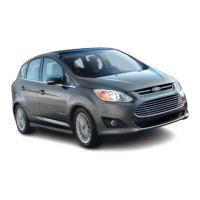
Do you have a question about the Ford 2013 C-MAX ENERGI and is the answer not in the manual?
| Brand | Ford |
|---|---|
| Model | 2013 C-MAX ENERGI |
| Category | Automobile |
| Language | English |
Provides an overview of the owner's manual and general usage notes.
Details on using child safety seats for infants, toddlers, and young children.
Information on selecting and using belt-positioning booster seats for older children.
Explains the fundamental principles of using safety belts correctly for optimal protection.
Describes the vehicle's system to alert occupants about unbuckled safety belts.
Details the dual-stage airbags, their deployment, and safety precautions.
Explains the location, function, and safety advice for side airbags.
Describes the system for unlocking the vehicle without a physical key.
Step-by-step guide on programming a key with restricted driving modes via the information display.
Details on using power door locks and central locking systems.
Explains the vehicle's engine immobilization system for theft protection.
Explains how to use the cruise control system to maintain a set speed.
Information on operating windshield wipers, including intermittent and speed-dependent modes.
Details on the automatic windshield wiper system activated by rain sensors.
Explains the function of automatic daytime running headlamps for visibility.
Instructions for operating power windows, including one-touch and global opening.
Explains the function and use of blind spot mirrors for increased visibility.
Explains the various warning lamps and indicators that alert the driver to vehicle conditions.
Describes how to use steering wheel controls to navigate the cluster information display.
Information on operating the audio system, including radio and CD functions with SYNC.
Explains the automatic operation of the climate control system for optimal comfort.
Guidance on achieving a proper driving position for safety and comfort.
Information on operating and safety precautions for heated seats.
Instructions for programming the HomeLink system to operate garage doors and other devices.
Information on the 110-volt AC power outlet, its capacity, and safety warnings.
Description of the center console features, including cupholders and storage.
Instructions on how to start the vehicle using the push-button start system.
Explains the principles of hybrid vehicle operation and driving experience.
Guidance on selecting the correct fuel type and octane rating for the vehicle.
Safety precautions and steps for refueling the vehicle, including the capless fuel system.
Detailed instructions and safety precautions for charging the vehicle's high-voltage battery.
Explains the different transmission modes (P, R, N, D, L) and their functions.
Describes the system that holds the vehicle stationary on slopes to aid in starting.
Explains how the ABS system helps maintain steering control during emergency stops.
Details how regenerative braking assists the standard brakes and recovers energy.
Explains the indicators and messages related to the traction control system's status.
Describes how the system helps maintain vehicle control on slippery surfaces and prevent rollovers.
Explains the automated system for parallel parking the vehicle.
Details the rear view camera system, its guides, and operation.
Describes the feature that optimizes acceleration for better fuel economy.
Information on the electric power steering system, its diagnostics, and operation.
Explains how to determine the vehicle's weight capacity for occupants and cargo.
Provides guidelines for towing the vehicle on all four wheels, including emergency and recreational towing.
Tips and advice on how to improve fuel economy through driving habits and maintenance.
Safety considerations and procedures for EV/HEV vehicles in emergencies like crashes or fires.
Step-by-step instructions and safety precautions for jump-starting a disabled vehicle.
Provides a chart of fuse ratings and the components they protect.
Procedures for checking and adding engine oil, including resetting the oil life monitor.
Guidance on checking and replacing the engine air filter element.
Instructions on checking and inflating tires to the recommended pressure.
Details on the tire repair kit, its components, and usage for temporary mobility.
Lists technical specifications for the 2.0L ATK iVCT engine.
Information on available Ford Custom Accessories and their warranty.
Details the various Ford ESP plans, coverage, and benefits like roadside assistance.
Explains how maintenance intervals and proper service protect vehicle performance and resale value.
Recommends a multi-point inspection at scheduled maintenance intervals for early issue detection.
Provides the schedule for changing engine and inverter system coolant.
Instructions on using voice commands to control vehicle features for hands-free operation.
Explains how SYNC collects and uses vehicle and phone data, and privacy controls.
Lists features that are limited or unavailable when the vehicle is in motion.
How to customize voice recognition interaction levels, prompts, and volume.
Options for accessing and playing media through the touchscreen or voice commands.
Troubleshooting common issues with SIRIUS satellite radio reception and functionality.
Voice commands for controlling CD playback functions.
Location and usage of SD card slot and USB port for media playback and charging.
General troubleshooting tips for USB/Media and phone issues with SYNC.
Overview of phone features available through SYNC, including hands-free calling.
Step-by-step guide for pairing a Bluetooth-enabled phone with the SYNC system.
Instructions on how to make calls using voice commands or the touchscreen.
Instructions for sending, receiving, and managing text messages via SYNC.
Options for customizing phone settings like ring tone, message notification, and Bluetooth.
Information on activating and using SYNC Services for traffic, directions, and information.
How to receive driving directions through SYNC Services via voice or touchscreen.
Voice commands for accessing SIRIUS Travel Link features like weather and sports.
Details on the 911 Assist feature for automatic emergency calls after a crash.
Instructions on how to activate and run vehicle health reports for diagnostics and maintenance.
How to set the vehicle's clock and manage time-related settings.
Instructions for adjusting touchscreen brightness, display mode, and wallpaper.
Details on the automated system that assists with parallel parking.
Settings and adjustments for the rear view camera system.
Information on vehicle Wi-Fi settings and connecting to wireless networks.
Access to system information, software licenses, and voice command lists.
Access to climate control features and temperature settings.
Voice commands for controlling the climate system, including temperature and airflow.
Introduction to the navigation system, its features, and SD card requirements.
Steps for setting a destination using the touchscreen or voice commands.
Explains the different map display modes (2D, 3D) and how to use them.
Explains the meaning of various icons displayed on the navigation map.
Describes the quick-access buttons on the map display for setting destinations and preferences.
General overview of MyFord Touch features and limitations.
Legal agreement governing the use of SYNC software and related components.
Outlines limitations regarding speech recognition, reverse engineering, and software transfer.
Critical safety warnings and instructions for using the Windows Automotive system.
The legal agreement for using the TeleNav navigation software.
Legal terms and conditions for using NavTeq map data.
Copyright information for Gracenote software and related data.











